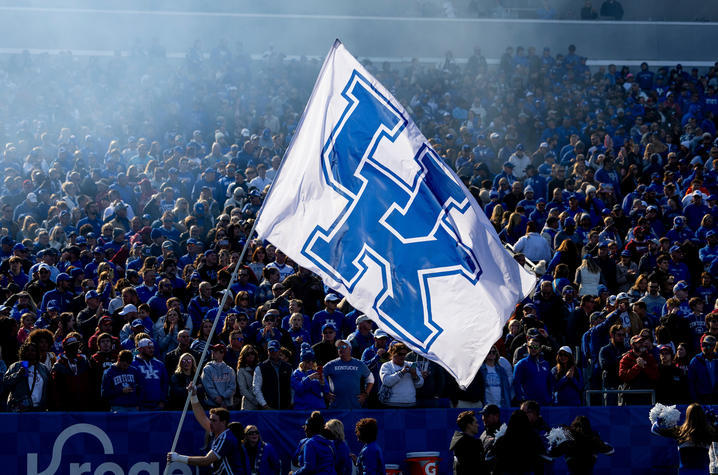‘UK at the Half’: The psychology behind sport rivalries

LEXINGTON, Ky. (Feb. 21, 2025) — In this “UK at the Half,” Matt Moore, associate dean of academic and student affairs in the University of Kentucky College of Social Work (CoSW), and Tarkington Newman, director of the CoSW Sport Social Work Research Lab, discuss the psychology behind rivalries.
Both agree — they are more than competition; they’re a powerful blend of identity, emotion and instinct.
Fans, dressed from head to toe in their team’s colors, swarm the stadium chanting fight songs and waving banners. It’s game day, and the stakes feel monumental. Sports rivalries are a cornerstone of athletic culture — sparking packed bleachers, passionate debates and unforgettable moments.
Rivalries and social identity
Sports rivalries are deeply rooted in social identity theory, which suggests that people gain self-esteem from being part of a group.
A rival team serves as the “out-group,” creating a clear “us vs. them” dynamic. This contrast strengthens loyalty to one’s own team and builds a sense of community among fans.
“Fans really do come in knowing that this is going to be the big rivalry game for us, and they get themselves to believe it,” Moore explained. “Whether or not you think it should be a rivalry, because of the media attention and how much it means to the community, it becomes a part of the fabric of who you are.”
The role of emotions
Rivalries evoke intense emotions that keep fans engaged.
From exhilaration to frustration, the hype is heightened when the opponent is a long-standing rival. And this emotional investment strengthens fans’ connection to their team and the rivalry itself.
“A lot of it hinges on identity — my identity is tied to this sport, this team and the success we have, either as individuals or a collective group,” Moore said. “When things go against that identity, it causes reactions that don’t always show our best selves.”
“I also think it goes back to relationships,” Newman added. “When you trace rivalry games — whether high school, college or professional — it often goes back to relationships between players or coaches, both good and bad.”
Geography and history
Many rivalries stem from regional pride and a shared history of fierce competition. Teams located near each other often face-off more frequently, and these repeated matchups can intensify tensions over time.
“Obviously, history and culture play a factor in creating rivalries,” Moore continued. “When schools or programs have had longstanding success, rivalries naturally form. And that often transcends for years, decades, even, which is a thing of beauty.”
The dark side of rivalries
While rivalries can create excitement and camaraderie, they can also escalate into hostility or even violence. Studies show that fans are more likely to exhibit aggressive behavior toward rival teams or their supporters.
Psychologists caution that this aggression often stems from deindividuation — when people in a group setting lose their sense of individual responsibility.
“We emphasize certain rivalry games so much that we don’t always think about how to respond if things don’t go our way,” Newman said. “At the end of the day, it’s just a game. Sometimes we let rivalries become too much of our identity, relationships and emphasis.”
“There’s great research on how spectator behavior impacts the well-being of athletes,” Moore added. “It’s scary to think that athletes and coaches are subjected to harmful behaviors. Fans get fired up, but we need to remember that behind the jerseys and helmets are real people — humans with struggles beyond sports. While athletes have incredible talents, they still deal with the same human challenges as anyone else.”
Why we keep coming back
Despite the emotional highs and lows, fans return to rivalry games season after season. Rivalries offer a sense of drama, continuity, and identity that few other experiences can match.
As fans gear up for their next big rivalry game, it’s worth remembering that the intensity they feel is rooted in a mix of psychology, culture and human nature. So, whether it’s cheering for the home team or booing the rival, the drama of competition continues to captivate us all.
“Sports are powerful because they have a shared language,” Newman said. “You can go to another country, not speak the language, but if there’s a soccer ball on the ground, you both know what to do with it. It’s an opportunity to engage with each other through this shared experience.”
“Sport is one of the few things that can unite mass groups of individuals,” Moore continued. “Sport can be a driving force for communities impacted by disaster or political strife — bringing people together. Ultimately, it’s a common language that transcends boundaries and borders.”
“UK at the Half” airs during halftime of each UK football and basketball game broadcast on radio and is hosted by UK Public Relations and Strategic Communications. To hear the “UK at the Half” interview, click on the play button above.
As the state’s flagship, land-grant institution, the University of Kentucky exists to advance the Commonwealth. We do that by preparing the next generation of leaders — placing students at the heart of everything we do — and transforming the lives of Kentuckians through education, research and creative work, service and health care. We pride ourselves on being a catalyst for breakthroughs and a force for healing, a place where ingenuity unfolds. It's all made possible by our people — visionaries, disruptors and pioneers — who make up 200 academic programs, a $476.5 million research and development enterprise and a world-class medical center, all on one campus.




